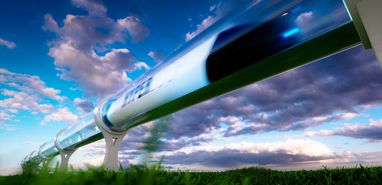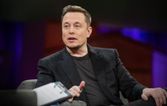
Elon Musk has announced that the first Hyperloop tunnel is almost completed. He claims that the tunnel will open to the public on Dec 10th. The super-fast train Musk and his company, “The Boring Company” has been promising this technological leap forward since 2013. Standing on the verge of its inception, there are still a lot of questions about what Hyperloop is, and what it can do for us.
The original concept
Back in 2012, Elon Musk suggested something called The Hyperloop as a new form of transportation. It would be twice as fast as a plane, but completely solar powered, and rely on green energy resources. The concept has changed from design to inception, but the idea was to cut down on wind resistance and friction, to reach speeds traditional transportation methods can’t do. As space-aged as a tube train may sound (and look) it’s not a new concept. The first person to come up with the idea was George Medhurst, an inventor in ‘799. The pneumatics he used were rudimentary, but they became the basis for everything Elon Musk is trying to achieve with Hyperloop.
Pneumatics and magnetics
So let’s break down the science. Originally, Musk imagined the Hyperloop as something like the pneumatic tubes that are still found in older mail rooms and public transportation in the mid-1850ss. NASA even used pneumatic tubing to send messages between their departments as early as the 90s. But today, most Hyperloop engineers use magnetic levitation, also known as Maglevs. The systems take less energy than standard Maglev systems, by using permanent magnets on the vehicles. In this way, the cars themselves create their own magnetic field. This allows an almost total lack of friction. And encasing the whole thing in a tube ensures you cut down on wind resistance. That, and the vacuums added to suck the air out, mean you’re able to keep cruising on very little energy. Musk’s original design also had solar panels on top of the trains, to utilize more clean energy. And that will drastically cut down on energy costs.
The benefits Of Hyperloop

In our increasingly interconnected world, it’s easy to see the benefits of a super speed mass transit system, like the one proposed by Elon Musk. But Hyperloop technology has many other benefits:
Incredible speeds
When we say its fast, it’s really, really fast. Right now, Elon Musk is aiming for an NY to LA commute that is half an hour long. The fastest mode of transportation right now is an airplane ride, which takes about six and a half hours if you can get a non-stop flight. And of course, that’s not even considering the carbon footprint of the average jet.
Greener energy
One of the major draws for the Hyperloop technology is that it uses cleaner energy. The original pneumatic design has been swapped out to include a system of magnets, which not only include magnets on each vehicle and the track, but an opposing magnet every few feet to give the trains a boost in speed. The technology is getting good enough that Musk, and the many companies trying to be first in the race for a commercial hyperloop system, believe that it will even eventually get cars off the road entirely.
Better commute
Speaking of public transportation, Hyperloop is touted as being the next great evolution in your commute. Not only is it fast, but it’s cheap, with a ride across the country, again, from NY to LA, costing only around $60. Compare that to the average bus or plane fare. It may even change the way cities are structured. The more people who can safely and conveniently get to work no matter where they live, the more are likely to move outside the core of the cities. Life in the suburbs would certainly get a lot easier if your commute was a five-minute Hyperloop drive that cost less than bus fare!
It’s safe
Hyperloop designs are almost impervious to weather conditions, and even earthquakes. Though there may be some shaking when you get to top speeds, top speeds approach the speed of sound and aren’t recommended for your commute.
A global phenomenon
All over the world, companies have started working on the problems of Hyperloop. A Chinese team wants to build on Musk’s original work to create an underwater Hyperloop, while in America, Hyperloop One continues to test their designs, working toward the breakthrough that will reach 760 MPH.
The downsides
With so many minds working on the practical problems of Hyperloop technology, it shouldn’t be too long before we start seeing Hyperloop tracks revolutionizing our transit system, right? Well, not exactly. The cost alone is enough to make feasible Hyperloop transit difficult right now. A single track from LA to San Francisco could cost up to $8 billion. According to Elon Musk’s original paper, the cost would need to be offset by the expense of the ticket prices. And that still doesn’t factor in the cost of maintaining a transit system that is in its infancy.
Scientists have also voiced some safety, stating that the Hyperloop basically takes the risks of being in space to just a few centimetres of earth’s surface. An accident would result in the death of all passengers due to the explosive decompression.
Still, the technology is promising. And Musk is convinced the Hyperloop technology itself is just around the corner. It may be a few years before the mass transit revolution we’re all hoping for, but as they say, the future is now. The advances made by the teams and startup companies who have tackled the idea since the original paper in 2013 suggest that we are well on our way. And Elon Musk himself shows no wavering in his confidence. He claims that we will all be able to enjoy the free rides on the morning after the big day in December when the first Hyperloop is finally revealed. It’s plenty to think about, but as of right now, the future of the technology looks bright!

By Andrej Kovacevic
Updated on 26th March 2019